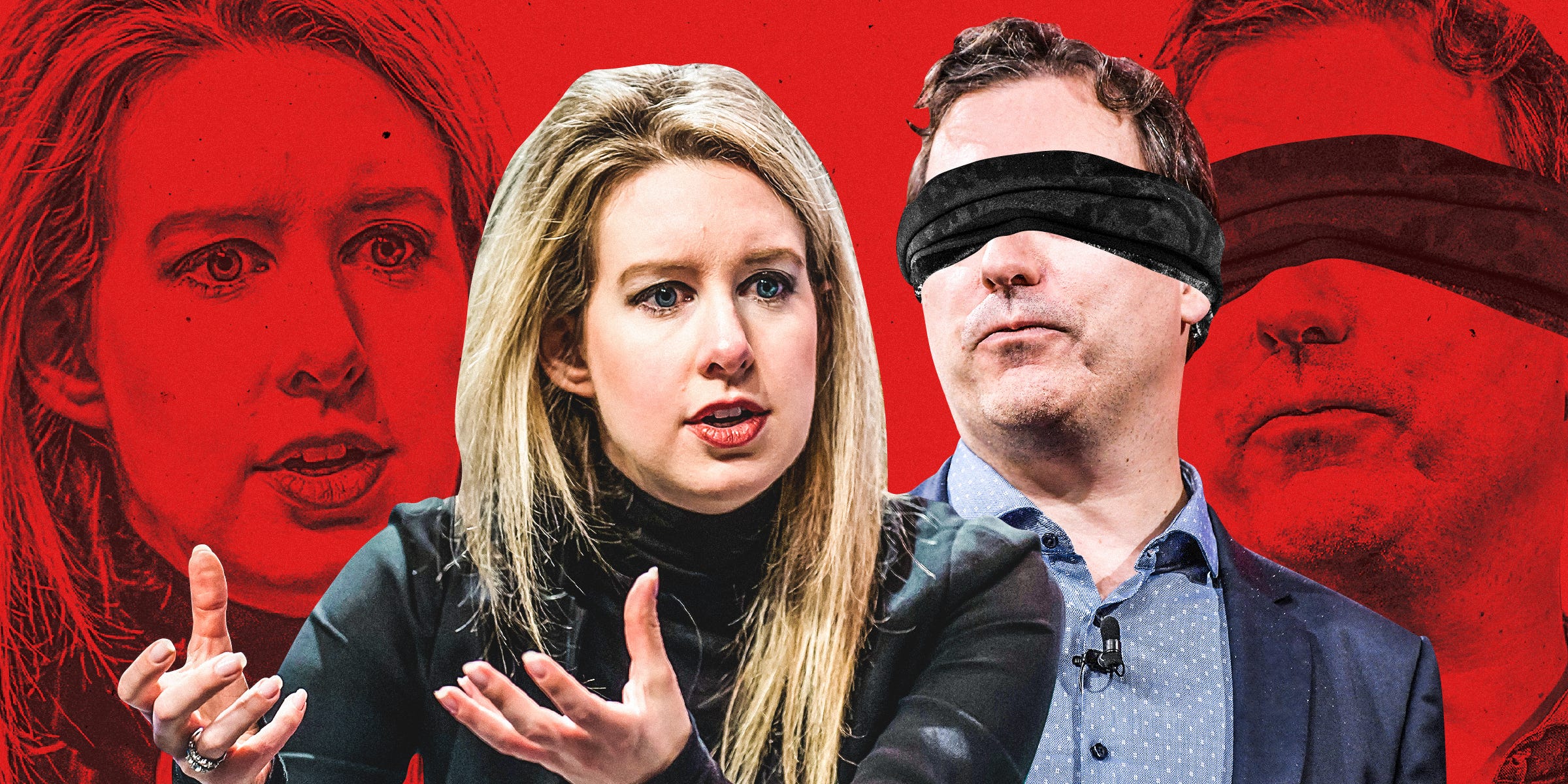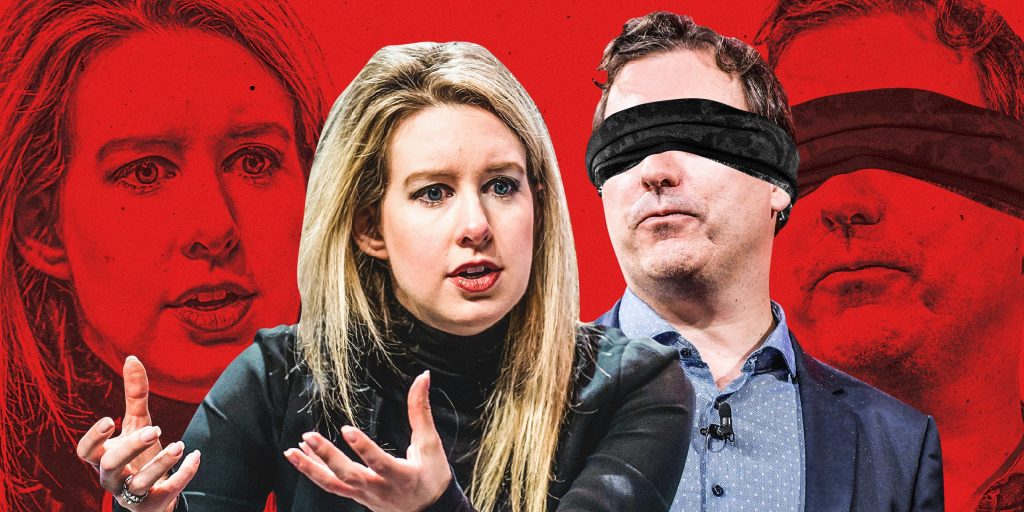
Gilbert Carrasquillo/Getty Images; Michael Loccisano/Getty Images; Samantha Lee/Insider
Prosecutors and defense attorneys are battling over Elizabeth Holmes in her fraud trial, but the news media is also an active litigant in the proceedings. Journalists and their publications have argued three separate matters before the court, reflecting both the high-profile nature of the case and the prominent role that journalism played in the demise of Theranos.
The best-known journalist by far on all things Theranos is John Carreyrou, the former Wall Street Journal reporter who broke the story about its deceptions and then wrote the best-selling "Bad Blood: Secrets and Lies in a Silicon Valley Startup." Carreyrou is a central figure in the saga. He was a thorn in the side of the company before its collapse. In his podcast, "Bad Blood: The Final Chapter," he is an unapologetic antagonist of Holmes, focusing on the voluminous evidence of her guilt and her efforts to evade accountability.
In return, Holmes' lawyers have exacted a bit of revenge on Carreyrou. By adding him to their list of possible witnesses, they subjected him to a gag order that prevented him from discussing the case with anyone but his lawyer and barred him from even attending the trial when other "fact witnesses" are testifying. That was a bitter pill for a reporter who was missing out on the coda of his career-defining story.
But Carreyrou, always pugnacious in his reporting, fought back in court as well. He filed a motion requesting an exemption from the gag order and his courtroom ban, based on his First Amendment rights as a journalist. His lawyer's brief noted that Carreyrou was the only reporter on the Holmes witness list, and that the defense hadn't subpoenaed him to testify. Citing page after page of case law, the brief sniped at Holmes: "Other courts, when faced with such a cynical ruse, have rightly rejected it in favor of reporters' First Amendment interests."
It's plainly laughable that Holmes' lawyers would call Carreyrou to testify. Whatever question marks they might hope to place on his reporting would pale in comparison with the mountain of embarrassing evidence the prosecution would elicit from him on cross-examination. A magistrate judge, Nathanael Cousins, held a hearing yesterday to settle the issue. He tried to seek a compromise, asking both sides to consider declaring Carreyrou an "expert witness" rather than a fact witness, which would permit him to attend the trial. But the defense refused to change its position.
In the end, Carreyrou won a resounding victory. In his ruling from the bench, Cousins noted Carreyrou's "centrality" to the case and praised him for "providing a public service" with his reporting. He lifted both the gag order and the courtroom ban, allowing Carreyrou to attend the proceedings as he sees fit.
The other journalist who filed a motion with the court is Roger Parloff, who wrote a flattering cover story about Theranos in Fortune magazine in 2014, a year before Carreyrou's exposé. (I was Parloff's colleague when he published his article but played no role in the piece.) Later, Parloff admirably published an extensive story documenting how he had been misled by Holmes. Parloff's articles have become a major plank in the government's case - prosecutors plan to call him as a witness, to demonstrate that Holmes lied to him to mislead investors.
Parloff's case is different from Carreyrou's. Parloff already has provided notes and transcripts of his interview with Holmes to both the prosecution and the defense. And he plans to testify. What he objected to is that Holmes has subpoenaed him to present interview notes with other sources - a move his lawyer called a fishing expedition that violated Parloff's reporter's privilege.
At yesterday's hearing, the magistrate also ruled in Parloff's favor. He specifically agreed with Parloff's fishing-expedition charge, calling the details Holmes was seeking to unearth "faux specificity." The score now stands at The Media 2, Holmes 0.
Carreyrou, taking to Twitter, declared total victory. "I'm allowed back in the courtroom to cover the Elizabeth Holmes trial," he wrote, noting that Parloff also won his motion. "All in all, a good day for the press!"
Jurors are eyeing the exits
The third journalistic matter before the court was brought by a group called The Media Coalition, consisting of ABC News, Dow Jones, The New York Times, and other media outlets. The coalition has asked the court to unseal the written questionnaires provided by the jurors and alternate jurors in the trial. During a hearing over Zoom on September 30, the group's lawyer, Steven Zansberg, argued that Judge Edward Davila was wrong to offer the jurors confidentiality, with a few exceptions regarding privacy and safety. The questionnaires, he insisted, are public information, and the public has a right to see them.
The hearing wasn't particularly notable from a legal perspective. But it offered a rare opportunity to see the faces of all the principals in the case. In court, the judge wears a mask except when he's sipping from his coffee mug; the lawyers, who take off their masks when speaking, generally face away from those of us seated on the wooden benches behind them.
Zansberg, who told the judge he was attending the hearing from an in-person gathering of the Media Law Conference, proudly held up a black mask with the slogan, "These are the only gag orders we support." Davila acknowledged that Zansberg had made his point. The conversation then digressed into a discussion about who is and isn't a reporter, from a legal perspective. "Who's a journalist?" the judge asked. "Does someone with a cellphone and a blog become a journalist?"
Zansberg neatly sidestepped the issue by reminding the judge that his clients "are not appearing as the press" but "are appearing as the people." Indeed, there's no special treatment of the press in Davila's courtroom. Were he to allow media accreditation and reserve seats for reporters - as the US Supreme Court did in its first oral arguments of the coronavirus pandemic - we wouldn't have to queue up along with everyone else. (End of disgruntled aside.)
After a ridiculous amount of back-and-forth, Davila met in his chambers with jurors who expressed qualms about their questionnaire being unsealed. Then he announced he would solicit additional briefs on the matter and hold yet another hearing in five to six weeks.
The judge has every reason to delay his decision as long as possible. He has already excused two of the original 12 jurors since the trial began - one because serving conflicted with her work schedule, and another because she said that as a Buddhist, her commitment to love and forgiveness would make it impossible for her to punish Holmes. That leaves only three remaining alternates. The loss of additional jurors who feel spooked about the questionnaires could lead to a mistrial.
Last week, another juror approached the judge about being excused. The woman, who appeared to be a professional in her 30s or 40s, offered two reasons to dismiss her. First, she said, she was in anguish over the possibility of sending Holmes to prison. "She's so young," she told Davila. "It's her future. I don't know if I'm 100% ready to participate in something like this." Second, she said, she didn't feel that her command of English was up to the responsibility. "Being English not my first language," she said, "I could make a mistake or something."
The judge reminded her that any punishment Holmes received would be his job, not hers. She is required only to decide, based on the facts, whether Holmes is guilty of the charges she faces. It also became clear from their conversation that the juror's command of the English language was quite strong. She agreed to stay, and neither side asked for her to be excused. But prosecutors couldn't have been thrilled to hear of her sympathy for Holmes. If "she's so young" is what the jury is thinking at this point, it could presage a punishment-free future for the defendant.
